Arleen Williams's Blog, page 16
December 18, 2015
Muddling Memoir: Closure? Never.
December 18, 2003. It was a life time ago. It was yesterday. It was surreal. It was horrifying. I sat on a hard wooden bench in a crowded Seattle court room, my fourteen-year-old daughter at my side, as Judge Richard Jones read my sister's name and Gary Ridgway's sentence: "life imprisonment without the possibility of early release or parole."
I don't want to go back to that dark place. I don't want to re-enter those dreadful years my family and I suffered through. I made sense of them through words, by writing a memoir, The Thirty-Ninth Victim. Now, on the anniversary of the sentencing, I'm in pre-publication discussions regarding the re-release of that book, and I realize how hard I've tried to pack away the memories and how reluctant I am to dredge them once again to the surface.
But the truth is, the memories were never too deeply buried. I don't live in a cave. I live in Seattle. I read the news and see the television broadcasts.
November 30, 2001. After eluding capture for two decades in the worst serial murder case in the country, Gary Ridgway was arrested. Now, the last day of November each year is no longer the anniversary of my father's birth, but a reminder of my sister's murder, of the day her killer was finally put behind bars.
December 2003. Gary Ridgway was sentenced to life in prison without parole on 48 counts of first degree murder, and I completed a Notification of Changes in Conditions of Incarceration. An officer at the King County Regional Justice Center where I'd gone to retrieve the few items belonging to my sister assured me I'd be contacted if the prisoner was moved.
February 19, 2011. According to The Seattle Times, Ridgway was moved from the Washington State Penitentiary in Walla Walla to the very same King County Regional Justice Center. At some point he was returned to Walla Walla. I was notified of neither move.
September 3, 2015. I received the following email. I was so shocked, I failed to respond until it was already yesterday's news.
I’m a reporter with The Seattle Times. I am writing a story about the decision to transfer Gary Ridgway to a prison in Florence, Colo., where he will be placed in general population and allowed privileges including a job and contact with other inmates. I was wondering if you have any comment. The decision was made because Ridgway apparently was having some mental health problems after 11 years in what amounted to solitary confinement at Walla Walla, where he could not be placed in general population because he would be targeted by other inmates. I’m wondering if you have any comment.Thanks,Mike
September 18, 2015. News of the decision to return Ridgway from Colorado to Washington blanketed the media, and I cried tears bitter with the realization that our criminal justice system is as dysfunctional today as it was thirty years ago, when it allowed this man to kill some say as many as ninety women over a twenty year period. Still, after such colossal failure, Dave Reichert, the man in charge of the Green River investigation, built a political career on an arrest he never made.
On this twelfth anniversary of the sentencing of my sister's killer, I am still angry. The failures and incompetence of the system that contributed to her murder in 1983 are as glaring today as they were then. And no matter how many memoirs I write, that reality will not change.
It's a muddled mess this memoir writing, and the more emotionally charged, the more muddled. As a memoirist one must grow thick skin and a willingness to hold horror close. The idea of memoir writing as therapy just isn't reality.
After the original publication in 2008, readers often asked about the therapeutic affects of writing The Thirty-Ninth Victim. "Did it bring closure?" some wondered. The research and writing helped me understand and deal with family tragedy, but closure? Never.
I found the strength to share my story the first time, and I will do so again. Booktrope will re-release The Thirty-Ninth Victimin late 2016, and I will face the demons and unpack the memories as any memoirist must do because a published work requires marketing to find its way into readers' hands.
I've been writing this blog series with a focus on process and techniques of memoir writing, and I will continue to do so. But on this anniversary of the sentencing of my sister's killer, I jump forward to look at what it means, or what it has meant to me, to put a memoir into the world.
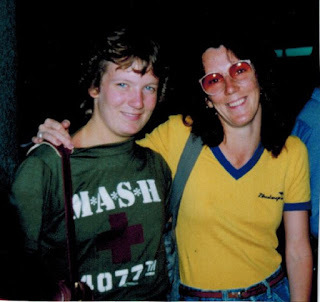 Maureen and Me, Mexico City 1982
Maureen and Me, Mexico City 1982Prior posts in this series:
Muddling Memoir: Beginnings
Muddling Memoir: Journals
Muddling Memoir: Letters
Muddling Memoir: Perspective
Muddling Memoir: A Timeline
Published on December 18, 2015 08:04
December 14, 2015
Muddling Memoir: A Timeline
I read the letters, a fragmented conversation between the twenty-something me and the parents I adored and deplored and didn't understand any better than I understood myself. I read and struggle to understand who that me was and why she was unable to accept the love so clearly expressed in her parents' letters.
I am also astonished by all I shared with my distant parents in those letters and equally appalled at how the older me was still unable to comprehend the overtures, gestures, expressions of love my parents showed me. All good fodder for a memoirist. A challenge for a middle-aged woman still curious about lives lived.
I read the letters and match content to journal entries marked with similar dates. Slowly a timeline emerges spanning the years from 1974 to 2009, a timeline far broader than the intended scope of this new memoir. I narrow the frame - 1979 to 1984 - a frame marked by significant events at both ends.
In writing a novel, the writer develops a storyline and plots scenes along a story arc. In some ways, a memoirist follows suit. But first, before I can focus on storyline or choose events (as opposed to creating them) to include or delete to enhance a story arc, I need a timeline. I need to dredge up the details of events, experiences, and emotions now buried for over three decades.
In The Art of Memoir, Mary Karr writes, "Some memories - often the best and worst - burn inside us for lifetimes, florid, unforgettable, demanding to be set down." The human brain - or is it the heart? - holds these major events, delightful and dreadful, but the memoirist seeks the details to link those events, the glue to hold them together. Tools at hand are journals, letters, photographs as well as long quiet walks, stacks of old LPs, and if I'm really lucky, reconnections with long lost friends.
One step at a time. Build a timeline. Create a table. Divide it into sections each labeled with a three month time period followed by three boxes: events, people/objects, and scenes. The first section reads "January, February, March 1979." A flexible guide, it is easy to add to or subtract from this table.
 One of my father's numerous skills was bricklaying. We, his clan of nine kids, were his brick carriers. "Stack them solid. Wide at the bottom. No cracks lined up. Build up from the base for strength," he told us. The same principal applied to stacking firewood, a solid base with cross sections at the ends to hold the wall of wood together even as we removed logs through the winter.
One of my father's numerous skills was bricklaying. We, his clan of nine kids, were his brick carriers. "Stack them solid. Wide at the bottom. No cracks lined up. Build up from the base for strength," he told us. The same principal applied to stacking firewood, a solid base with cross sections at the ends to hold the wall of wood together even as we removed logs through the winter. The lessons of childhood apply to my writing process. The framework for a memoir requires a solid base which in turn demands research and a timeline based on more than the dominant memories that cling and haunt and exact attention.
I am still at this step in the process - the research/timeline building step - and likely will remain here for months. At the same time, I write scenes as memories emerge, scenes that may or may not find their way into the finished memoir, but like my father's bricks, they are scenes that add structure as they dredge up more memories of a life once lived.
Prior posts in this series: Muddling Memoir: Beginnings Muddling Memoir: Journals Muddling Memoir: Letters Muddling Memoir: Perspective
Published on December 14, 2015 08:45
December 7, 2015
Muddling Memoir: Perspective
I procrastinated for a week. I did not want to dig deeper. I wasn't ready to read the letters between my mother and me. Was it fear of finding something I could no longer question her about, something impossible to double check with Dad? It was too late. I cannot query the deceased.
Creativity works in strange ways. I've always wanted to draw but never made time to learn. Earlier in the week I stopped at a local artist supply shop and bought my first drawing how-to. The book: Draw 3-D A Step-by-Step Guide to Perspective Drawing by Doug DuBosque. It was crumpled at the corners, a bit dusty, rejected. I found it on the floor under the book racks and knew it was the one for me.
At home, I dug around the house for an unlined journal and found my daughter's cast off journal with only the first dozen pages covered with the drawings and thoughts of an eight year old. It felt like the perfect fit. Convinced my daughter would enjoy the irony of her mother's efforts, I set to work teaching myself to draw. Interesting I chose a book on perspective.
As in visual art, perspective is essential to the creation of a strong memoir with universal appeal. In addition, the process as well as the completion of a memoir gives the writer new perspective on past events. The horizon line is different, we move the vanishing point a tad and we see the past from a slightly different angle. We gain perspective. Not closure, never closure. A memoirist does not close off memories. They are the fruits of an examined life. What changes is perspective.
Yesterday I opened two large envelopes of correspondence. Because my mother saved everything, I have both the letters I sent home as well as those sent to me. The collection begins with postcards dating July 1974 when I made my first trip to Mexico to a card from my mother dated November 2009 posted by the staff of the dementia care facility where her life ended. A card she could no longer write. She managed "Dear Dear Arleen" in her own shaky hand, and something more, something illegible. A volunteer wrote the remainder of the message and posted it.
I sorted those letters in chronological order, as I'd done with the letters from my friends. To do so, I pulled each letter from its envelope in search of a date. Where one was omitted, I tried to decipher the date on the postal stamp. What's unique here is that I was able to create a back-and-forth written conversation.
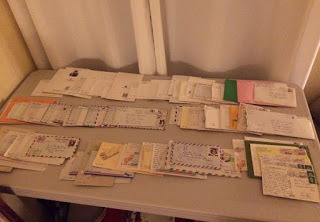 I have not yet begun to read this correspondence and already my perspective has shifted. I remembered it wrong. I thought all those letters were from my mother, written by my mother, a conversation between my mother and me. But I was wrong. At least half were written by my father. Memory again made of fool of me. Upset, I made my way to my 3-D drawing book and found solace in drawing straight lines to distant vanishing points.
I have not yet begun to read this correspondence and already my perspective has shifted. I remembered it wrong. I thought all those letters were from my mother, written by my mother, a conversation between my mother and me. But I was wrong. At least half were written by my father. Memory again made of fool of me. Upset, I made my way to my 3-D drawing book and found solace in drawing straight lines to distant vanishing points.Enjoying this blog series? To receive email notification of new posts, please subscribe by entering your email address in the box in the upper right column. Thanks!
Prior posts in this series:Muddling Memoir: BeginningsMuddling Memoir: JournalsMuddling Memoir: Letters
Published on December 07, 2015 06:08
November 30, 2015
Muddling Memoir: Letters
I opened Pandora's box, or rather Pandora's boxes. When I returned to my "Mexico Years" to explore the possibility of writing another memoir, I decided to dig out saved journals, photos, and letters.
My husband and I have lived in a very small house close to twenty-five years. Before that I lived in an even smaller cottage, and before that a one-bedroom Seattle apartment after five years and five months in two postage stamp apartments in Mexico City. I am amazed at how much stuff I saved, how easy it was to stash this stuff into nooks and crannies, and how overwhelming it became when it was time to take a peek.
The first box I found was pink cardboard covered in tiny white hearts that once held my daughter's dress-up collection. I was searching for Judi's letters. I met this British friend in Mexico and saw her again in England shortly before her death when we joked of writing The Ex-Mexican Wives Club. Stashed in the laundry room and crammed with yearbooks, merit badges, pictures, cards, letters, the box contained only a few of Judi's later letters. I was disappointed.
I dug deeper into the laundry room, the backs of closets, the crawl space under the stairs. On the floor of the linen closet, shoved deep behind my basket of journals, I found a large plastic storage bin of letters.
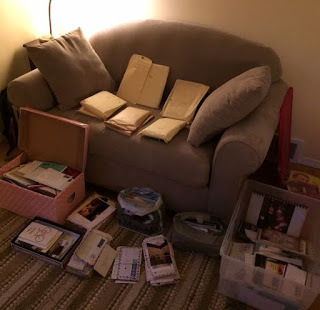
Several days went into sorting the letters into neat piles on the dining table by sender. Judi's letters were in that box along with letters from friends I've long lost contact with, letters from my Mexican ex-husband, and letters from people I no longer even remember. There were letters from my deceased parents and sister, and letters from each of my living siblings. I diligently labeled Ziploc bags and packaged what I recognized as an overwhelming wealth of research material.
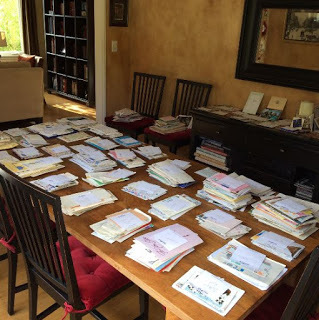
Before settling into reading mode, I decided to give the house another sweep. Sure enough one more box was lodged behind a box of books on the floor of my clothes closet. I returned to the dining table and added this new box full of letters to the plastic bags. I haven't gone up into the attic yet, but I'm reasonably confident there's nothing there. Yet as I write these words, I know I will check.
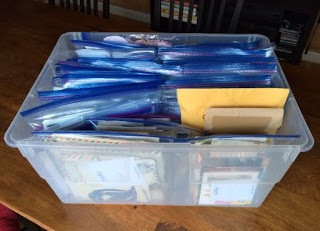 I've begun reading these letters. I sort the collection in each plastic bag into chronological order and begin with the earliest. The letters reveal timelines and facts, experiences and emotions of the writer as she or he responds to my prior letter. I have only one side of these conversations, with two profound exceptions, but even that is plenty to fill in gaps and prod faded memories.
I've begun reading these letters. I sort the collection in each plastic bag into chronological order and begin with the earliest. The letters reveal timelines and facts, experiences and emotions of the writer as she or he responds to my prior letter. I have only one side of these conversations, with two profound exceptions, but even that is plenty to fill in gaps and prod faded memories.The two exceptions? Mom and Maureen. I didn't know how much my mother saved until I spent weeks sorting and emptying her house after my siblings and I made the difficult decision to move her into a dementia care facility. There was much I didn't know about my mother, but uncovering baby books, hospital bracelets, report cards, school projects, and saved letters from each of her nine children shocked me to my core.
At the time I was on a mission to sort and empty the house. I created nine piles, one for each sibling. It was not a popularity contest. There was no favorite child. The piles varied in size largely based on the physical distance between parents and kid, and how often we each wrote home. I didn't read the letters I'd sent to my Mom and Dad through the years, or those I'd sent to my youngest sister. It was too soon, too painful. I put them in a box and stashed them away.
Now I will read those letters. All of them. In my Pandora's boxes, I will find the memories and truths hidden in words penned in a world before email made the art of letter writing obsolete.
Enjoying this blog series? To receive email notification of new posts, please subscribe by entering your email address in the box in the upper right column. Thanks!
Prior posts in this series:Muddling Memoir: BeginningsMuddling Memoir: Journals
Published on November 30, 2015 06:59
November 23, 2015
Muddling Memoir: Journals
"Is there anything you'd like to include?" the attorney asks.
"I'm wondering if there's any way to ensure my journals are never read after my death," I say.
My husband and I have finally met with a professional to create a will. She adds a note, but I'm certain it is insufficient. I know I need to destroy my own journals when the time is right. But when is right?
My first journal was a sister's gift as I departed on a solo Greyhound trip to California and flight to Mexico. The first entry reads 7-2-74. I was nineteen. I hold this journal here beside me as I scribble these words.
 I also have an overflowing storage bin crammed with others. These journals hold decades of secret thoughts, experiences, and emotions as well as the early scribbles of scenes for every book I've written. They are private and without them I could never have written those books.
I also have an overflowing storage bin crammed with others. These journals hold decades of secret thoughts, experiences, and emotions as well as the early scribbles of scenes for every book I've written. They are private and without them I could never have written those books.
 Over the past months I transcribed the journals from the five years and five months I lived in Mexico City in the early 1980s. In the process, I discovered something interesting: a coming-of-age metaphor in a foreign city, the most populous city in the world at the time, a city that spoke a language I was only just learning.
Over the past months I transcribed the journals from the five years and five months I lived in Mexico City in the early 1980s. In the process, I discovered something interesting: a coming-of-age metaphor in a foreign city, the most populous city in the world at the time, a city that spoke a language I was only just learning. My early entries are in English. As months passed, English mixed with Spanish, a word here, a sentence there. Toward the end of my life in Mexico, Spanish dominated my pages. Now I struggle not only to understand that younger me but also the language she mastered.
Without my journals, the thoughts and experiences of that girl would be lost. I'd venture to say that without those journals this woman would be lost as well, and this writer, certainly this memoirist, would not exist.
I live an examined life, but I do not want my unfiltered journals
Enjoying this blog series? To receive email notification of new posts, please subscribe by entering your email address in the box in the upper right column. Thanks!
Prior posts in this series:Muddling Memoir:Beginnings
Published on November 23, 2015 06:09
November 16, 2015
Muddling Memoir: Beginnings
My husband comes home to a dining room strewn with research materials and a very moody, distant wife.
"Are you living too much in the past?" he asks.
"I'm a memoirist," I snap. "I have to go back there."
Later we talk. He understands memoir. He's lived through my writing of two earlier memoirs. He knows the value of facing the past head on and making sense of lives lived. I am fortunate. He is not threatened by my past. At the same time, I acknowledge the importance of finding balance, of not letting the past control the present, of making certain memoir writing does not overshadow present living.
The determination to understand one's past is fundamental to memoir. It requires honest self-examination which makes some writers uncomfortable and some readers disinterested. For me, truth - personal and historical truth - are vital to self understanding. I live an examined life and that examination has been my salvation.
Memoir writing also requires memory, or so one would assume, but remembering the people, events and emotions from twenty, thirty, forty years earlier can be challenging. That's where journal and letter writing, photography, and general pack-ratting are useful. Despite my travels, my moves, my instability for the first three decades of life, I seem to have saved everything. As a UC Santa Cruz archaeology student in the late 1970s, I had no idea I'd be using learned techniques to dig into my own past decades later. Perhaps those classes instilled in me the need to document my life and to preserve all.
I began a third memoir this past summer. In this new work, I return to the early 1980s when I was an ex-pat living in Mexico and to 2010 when three of us friends re-unite in London and reminisce about our shared experiences in that city. An idea surfaces and a title emerges: The Ex-Mexican Wives Club.
The challenge in writing this memoir is to re-enter a world so radically changed I no longer recognize it or myself. I am no longer that lost young woman. To write this memoir I must re-enter the confused mind of that twenty-something ex-pat in Mexico City who was me.
Over the next many months, I will be sharing my journey in memoir writing. Whether you are a writer interested in the form or a reader who loves it, I hope you'll join me.
Published on November 16, 2015 07:09
November 12, 2015
Some Things Never Change
I am grateful to author E.C. Moore for sharing this short piece in her blog series, An Honest to God True Story. If you missed it there, I hope you enjoy it here!
*****
My daughter sits beside me, her head on the pillow smashed against the car window as I drive. I take furtive glances in her direction as I maneuver Interstate 5 from Seattle to Portland. I admire the beauty of her sleeping face and am lost in memories of the face of a colicky newborn, the face of an energetic toddler, the face of a sullen teenager always gentle, peaceful, beautiful when relaxed in sleep.
A month earlier my daughter asked what I wanted for my birthday.
"You," I said. "A weekend with you in Portland." My daughter will be married in the coming year. She and her fiancé work full-time and have recently bought a home. She has a tight schedule, and now she is applying for grad school. Weekends alone with mom are a precious gift. I made the mother-daughter trip an annual ritual throughout my daughter's childhood. Our first trip alone together, we flew to San Francisco to visit one of my sisters. My daughter was four, small and pink in the airplane seat, her eyes wide with excitement, her arms clutching her white Bear-Bear. Thirty minutes into the short flight she slumped against the airplane window, Bear-Bear her pillow, her face peaceful perfection. Now, twenty two years later, as I drive toward Portland, I see that same perfection. Another mother-daughter trip, our first to Portland, she was a pre-teen. We took Amtrak. Again the movement lulled her to sleep, again I admired her beauty and felt pangs of jealousy of her slumber, of her beauty, of her oneness with the world. No, not jealousy really, maybe envy, maybe joy. I knew her trust allowed her peace, and that knowledge was my reward. At fifteen my daughter insisted on bringing a friend on our mother-daughter trip. I stalled and struggled. Was no trip better than one with a friend along? "But we've visited my aunties," she argued. "And we went to Lummi Island to see your friend. It isn't always just us." I had to admit she was right and went along with her plan. I felt like a chauffeur, the front seat beside me empty. When I looked in the rearview mirror, I saw the two testy teens in the backseat, deep in sleep, their heads on pillows against opposite doors, all traces of the testiness gone. I admired the beauty of my daughter's face and was reminded again of all our travels and all the stages of my daughter's life. I relaxed into the drive, the quiet, the peace. That was our last trip together for a while. Mother-daughter trips were not something my daughter showed interest in as she navigated high school and university. Maybe I should've pushed harder, made the trips more enticing, but she was off exploring the world on her own, and some part of me knew that's what she needed to do. Two months ago, when she asked what I wanted for my birthday, I hesitated. Rejection at any age hurts. "A trip to Portland," I said. "Fun," she said. "Let's stay at The Benson." We decide to drive and once again I bask in the peaceful beauty of my daughter's face as the movement of the car lulls her to sleep. I enjoy this amazing person who came from me and the memories of our life together. These are the unexpected birthday gifts my daughter gives me.
*****
My daughter sits beside me, her head on the pillow smashed against the car window as I drive. I take furtive glances in her direction as I maneuver Interstate 5 from Seattle to Portland. I admire the beauty of her sleeping face and am lost in memories of the face of a colicky newborn, the face of an energetic toddler, the face of a sullen teenager always gentle, peaceful, beautiful when relaxed in sleep.
A month earlier my daughter asked what I wanted for my birthday.
"You," I said. "A weekend with you in Portland." My daughter will be married in the coming year. She and her fiancé work full-time and have recently bought a home. She has a tight schedule, and now she is applying for grad school. Weekends alone with mom are a precious gift. I made the mother-daughter trip an annual ritual throughout my daughter's childhood. Our first trip alone together, we flew to San Francisco to visit one of my sisters. My daughter was four, small and pink in the airplane seat, her eyes wide with excitement, her arms clutching her white Bear-Bear. Thirty minutes into the short flight she slumped against the airplane window, Bear-Bear her pillow, her face peaceful perfection. Now, twenty two years later, as I drive toward Portland, I see that same perfection. Another mother-daughter trip, our first to Portland, she was a pre-teen. We took Amtrak. Again the movement lulled her to sleep, again I admired her beauty and felt pangs of jealousy of her slumber, of her beauty, of her oneness with the world. No, not jealousy really, maybe envy, maybe joy. I knew her trust allowed her peace, and that knowledge was my reward. At fifteen my daughter insisted on bringing a friend on our mother-daughter trip. I stalled and struggled. Was no trip better than one with a friend along? "But we've visited my aunties," she argued. "And we went to Lummi Island to see your friend. It isn't always just us." I had to admit she was right and went along with her plan. I felt like a chauffeur, the front seat beside me empty. When I looked in the rearview mirror, I saw the two testy teens in the backseat, deep in sleep, their heads on pillows against opposite doors, all traces of the testiness gone. I admired the beauty of my daughter's face and was reminded again of all our travels and all the stages of my daughter's life. I relaxed into the drive, the quiet, the peace. That was our last trip together for a while. Mother-daughter trips were not something my daughter showed interest in as she navigated high school and university. Maybe I should've pushed harder, made the trips more enticing, but she was off exploring the world on her own, and some part of me knew that's what she needed to do. Two months ago, when she asked what I wanted for my birthday, I hesitated. Rejection at any age hurts. "A trip to Portland," I said. "Fun," she said. "Let's stay at The Benson." We decide to drive and once again I bask in the peaceful beauty of my daughter's face as the movement of the car lulls her to sleep. I enjoy this amazing person who came from me and the memories of our life together. These are the unexpected birthday gifts my daughter gives me.
Published on November 12, 2015 06:12
November 6, 2015
Hibernation?
Are you looking to load your Kindle for a long, dark winter of reading? Personally, when daylight saving time ends, days shorten, and gray blankets Seattle, I'd like to hibernate, but apparently that's not an option. Instead I ignore what's going on outside by sticking my nose in a good book. If you're like me, you might like some reading suggestions.
It seems a little crazy to start thinking about holiday shopping three weeks before Thanksgiving, but what can you do? I saw a Christmas tree in my favorite after-walk pub last night, so apparently it's on us already. If you're an early shopper or just want to add a few good (cheap) reads for your own Kindle, check out these holiday deals.
My publisher, Booktrope, is running a special promotion called Prefunk the Holidays with over 200 titles at $2.99. Check it out at Runaway Goodness.

Amazon is already offering Holiday Deals with over a thousand titles listed.

And here comes the personal plug... my three novels are included in these special deals!
Running Secrets $1.99 Prime and $0.00 UnlimitedBikingUphill $2.99 Prime or $0.00 UnlimitedWalkingHome $2.99 Prime or $0.00 Unlimited
Happy winter reading!
Published on November 06, 2015 08:20
October 29, 2015
What Are YOU Working On?
As October ends and we gear up for autumn darkness, another blog series comes to a close. I'm grateful to all our contributors for sharing their thoughts. If you missed any of them, just click on the names in this list. Or better yet, search them on Amazon. Maybe you'll find something that whets your winter reading appetite.
Arleen WilliamsTerry PersunPamela Hobart CarterK. WilliamsE.C. MooreJudith WorksA.M. WillardKit BakkeJulia Park TraceyClaudia H. LongG. Elizabeth Kretchmer
What creative projects do you find twirling in your mind as leaves fall along with temperatures? For my own part, I continue to type old journals and write memories of the time when I was a young woman exploring life and self in Mexico City. I wrote in Spanish, a language I must now reacquaint myself with to understand the thoughts of that younger me. I do not know how much of this work will make it into my next book, but I'm grateful for the journals I kept. They now serve as a reality check of memories, partially forgotten or rewritten over time.
In all things - good and bad - I prefer truth. A journal allows me to hold to my own truth, the truth of the younger self rather than the interpretation warped by time and distance, accumulated experience and faded memories. Sometimes I recall the past and it appears far worse than it was. Other times I do the opposite, remembering a past time or event with those proverbial rose-colored lenses. My journal allows me to re-enter earlier thoughts to better understand experiences and emotions long past.
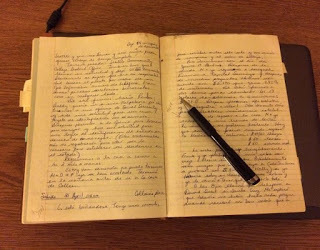 As I continue mining my journals, I search for inspiration in Daily Rituals: How Artists Work by Mason Currey and Big Magic: Creative Living Beyond Fear by Elizabeth Gilbert. Currey explores the creative habits and routines of 161 artists - from Austen to Armstrong, Faulkner to Fellini, Beattie to Balanchine - all struggling with the challenges of finding too much or not enough time for their work, dealing with creative demons and muses, balancing their creativity with a life that makes sense perhaps to only themselves. Elizabeth Gilbert tells us that "Art is a crushing chore and a wonderful privilege." She encourages us to allow ourselves to be the conduit of inspiration by coming to the table, putting in the seat time, and being open to the universe. By both, I am reminded how fortunate I am to live a creative life.
As I continue mining my journals, I search for inspiration in Daily Rituals: How Artists Work by Mason Currey and Big Magic: Creative Living Beyond Fear by Elizabeth Gilbert. Currey explores the creative habits and routines of 161 artists - from Austen to Armstrong, Faulkner to Fellini, Beattie to Balanchine - all struggling with the challenges of finding too much or not enough time for their work, dealing with creative demons and muses, balancing their creativity with a life that makes sense perhaps to only themselves. Elizabeth Gilbert tells us that "Art is a crushing chore and a wonderful privilege." She encourages us to allow ourselves to be the conduit of inspiration by coming to the table, putting in the seat time, and being open to the universe. By both, I am reminded how fortunate I am to live a creative life.What are YOU working on? I hope your projects fill you with wonder. I know they will also bring times of extreme frustration as well as deep joy. Follow your passion. Know yourself. Be true to you.
Published on October 29, 2015 06:43
October 22, 2015
What Are You Working On ... G. Elizabeth Kretchmer?
Today we have both an essay and an invitation from G. Elizabeth Kretchmer. I hope you can all join her Sunday afternoon!
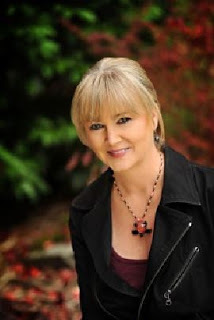
G. Elizabeth Kretchmer has an MFA in Writing from Pacific University. Her short fiction, essays, and freelance work have appeared in the New York Times, High Desert Journal, Silk Road Review, SLAB, and other publications. When she’s not writing, she’s facilitating therapeutic and wellness writing workshops. You can learn more about her at www.gekretchmer.com. Or better yet, join her at the Women on the Brink party this Sunday, October 25, at 4 pm at University Bookstore in Bellevue. Featuring contributing poets, UW actors, and Pearl and Stone Wine Co., this will be a one-of-a-kind launch party you won’t forget.
*****I used to think the writing life involved sitting in a rustic cabin at the edge of a Waldenish pond, thinking about life and making stuff up and writing it all down. Then I became a writer and realized that notion of the writing life was indeed pure fiction.
What have I been working on? For the last several months, it’s been marketing, marketing, marketing. I re-released my novel, The Damnable Legacy, in July, and I’m about to celebrate the launch of Women on the Brink at a party this Sunday. Which is all good, except I’m desperate to get back into the thinking and imagining and writing part.
I have, in fact, started my next project -- a novel set in the Yellowstone area. It’s predominantly contemporary but there will be a historical fiction component, dating back to the summer of 1877. (If you want to know what was so special about that year, Google it.)
As with my other work, this project will revolve around ordinary women facing life’s ordinary, and often unwelcome, obstacles. In real life, many of us harbor secret thoughts, fears, and resentments because society still requires that of us. We aren’t allowed to regret decisions of the past, or wonder aloud about our maternal angst, or admit that life isn’t all rosy under the covers. We post pictures on Facebook showing how happy we are and how many BFFs we have. We stifle our needs in part because we put others ahead of ourselves – that’s our nurturing nature – but in so doing we sometimes betray our authentic selves as we buy into the media’s (often male) representation of what being a woman should mean, rather than what it really does mean.
In my novel The Damnable Legacy, a woman still regrets the decision she made thirty years ago to place her daughter for adoption so she could selfishly follow her mountaineering dreams, but she cannot admit this mistake to anyone and must commit her thoughts only to her journal. Her story is not unusual; there are thousands of birthmothers in our country who hold their grief inside for the rest of their lives because they are told to move on.
My characters in Women on the Brink, a collection of short stories, wrestle with a variety of secrets and resentments, like husbands who expect them to be more perfect than they are or children who need more than their mothers can give. These women grieve their failed relationships with their sisters. They make difficult decisions for their aging mothers. They go through life’s motions until they no longer can.
So the truth of the matter is this: what I’m working on is not just another novel. What I’m working on is deciding which of the many universal issues of being a woman are most compelling for me, at this point in my life, and should thus be given a voice in my next novel.
To receive email notice of new posts, please subscribe by entering your email address in the box in the upper right
To read the prior posts, go to the posts listing in the left side bar. If titles are no longer visible, just click on any month to select.
And finally, if you have a guest post you'd like to share on this blog, email me at aw@arleenwilliams.com.
Published on October 22, 2015 05:53



